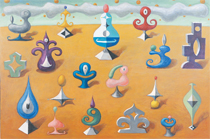 |
 |
||||||||||||||
| features columns jumbolaya planet tufts newswire the big day Departments The Issue Letters Bookshelf Afterimage |
 |
Afterimage
Landscape #2
Paul Cézanne observed that “everything in nature takes its form from the sphere, the cone, and the cylinder.” I’ve taken that statement to heart in my own work, which is all about describing forms—those same spheres, cones, and cylinders—in an imaginary space. The painting shown here is from my “landscapes” series. I think of the figures as small sculptures, and I freely change them and move them around, experimenting with color and form. In complex compositions like this one, the shapes are arranged on a kind of tabletop. I use a simple horizon line to imply a landscape.
Lately, my focus has moved to printmaking. One subject has been fossils from Canada’s Burgess Shale—500-million-year-old animals that developed strange, segmented bodies with five eyes, spiked limbs, and elephant-like noses, as if taken from a Picasso painting. I’ve also drawn inspiration from my work as an art conservator specializing in antique globes. These beautiful objects, made of intaglio-printed paper cut and pasted onto spheres, were built in pairs, one terrestrial and one celestial. (My own series of globes is currently on display at 13 Forest Gallery in Arlington, Massachusetts.) In antique maps and globes, the cartographer would try to show land or objects from above and at an angle simultaneously, creating the same type of imaginary space I aim for in my work.
—David Colombo, SMFA82